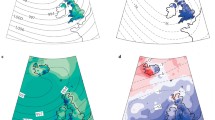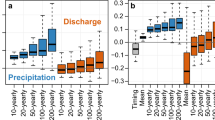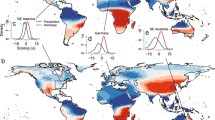Abstract
Radiative effects of anthropogenic changes in atmospheric composition are expected to cause climate changes, in particular an intensification of the global water cycle1 with a consequent increase in flood risk2. But the detection of anthropogenically forced changes in flooding is difficult because of the substantial natural variability3; the dependence of streamflow trends on flow regime4,5 further complicates the issue. Here we investigate the changes in risk of great floods—that is, floods with discharges exceeding 100-year levels from basins larger than 200,000 km2—using both streamflow measurements and numerical simulations of the anthropogenic climate change associated with greenhouse gases and direct radiative effects of sulphate aerosols6. We find that the frequency of great floods increased substantially during the twentieth century. The recent emergence of a statistically significant positive trend in risk of great floods is consistent with results from the climate model, and the model suggests that the trend will continue.




Similar content being viewed by others
References
Cubasch, U. in Climate Change 2001: The Scientific Basis (eds Houghton, J. T. et al.) Ch. 9 (Cambridge Univ. Press, Cambridge, 2001).
White, K. S. et al. Technical Summary in Climate Change 2001: Impacts, Adaptation and Vulnerability (eds McCarthy, J. J. et al.) 19–73 (Cambridge Univ. Press, Cambridge, 2001).
McCabe, G. J. Jr & Wolock, D. M. Climate change and the detection of trends in annual runoff. Clim. Res. 8, 129–134 (1997).
Lins, H. F. & Slack, J. R. Streamflow trends in the United States. Geophys. Res. Lett. 26, 227–230 (1999).
Groisman, P. Ya., Knight, R. W. & Karl, T. R. Heavy precipitation and high streamflow in the contiguous United States: Trends in the twentieth century. Bull. Am. Meteorol. Soc. 82, 219–246 (2001).
Knutson, T. R., Delworth, T. L., Dixon, K. W. & Stouffer, R. J. Model assessment of regional surface temperature trends (1947-1997). J. Geophys. Res. 104, 30981–30996 (1999).
Pearson, K. Tables for Statisticians and Biometricians 3rd edn (Cambridge Univ. Press, Cambridge, 1930).
Delworth, T. L. et al. Simulation of climate variability and change by the GFDL R30 coupled climate model. Clim. Dyn. (submitted).
Chase, T. N., Pielke, R. A. Sr, Kittel, T. G. F., Nemani, R. R. & Running, S. W. Simulated impacts of historical land cover changes on global climate in northern winter. Clim. Dyn. 16, 93–105 (2000).
Milly, P. C. D. & Dunne, K. A. Trends in evaporation and surface cooling in the Mississippi River basin. Geophys. Res. Lett. 28, 1219–1222 (2001).
Sellers, P. J. et al. Comparison of radiative and physiological effects of doubled atmospheric CO2 on climate. Science 271, 1402–1406 (1996).
Milly, P. C. D. Sensitivity of greenhouse summer dryness to changes in plant rooting characteristics. Geophys. Res. Lett. 24, 269–271 (1997).
Milly, P. C. D. & Dunne, K. A. Macroscale water fluxes: 1. Quantifying errors in the estimation of basin-mean precipitation. Wat. Resour. Res. (submitted).
Milly, P. C. D. & Wetherald, R. T. Macroscale water fluxes: 3. Effects of land processes on variability of monthly river discharge. Wat. Resour. Res. (submitted).
Acknowledgements
Streamflow data were collected and/or provided to us by the Global Runoff Data Centre (Germany), the US Geological Survey, Environment Canada, EarthInfo, Manaus Harbor Ltd/Portobras and Departmento Nacional de Aguas e Energia Electrica (Brazil), National Institute of Meteorology and Hydrology (Romania), J. Cordova, N. Garcia and J. Richey. We thank K. L. Findell, D. P. Lettenmaier and R. J. Stouffer for comments and suggestions.
Author information
Authors and Affiliations
Corresponding author
Ethics declarations
Competing interests
The authors declare no competing financial interests.
Rights and permissions
About this article
Cite this article
Milly, P., Wetherald, R., Dunne, K. et al. Increasing risk of great floods in a changing climate. Nature 415, 514–517 (2002). https://doi.org/10.1038/415514a
Received:
Accepted:
Issue Date:
DOI: https://doi.org/10.1038/415514a
- Springer Nature Limited
This article is cited by
-
Global prediction of extreme floods in ungauged watersheds
Nature (2024)
-
Significantly wetter or drier future conditions for one to two thirds of the world’s population
Nature Communications (2024)
-
Flash floods in Mediterranean catchments: a meta-model decision support system based on Bayesian networks
Environmental and Ecological Statistics (2024)
-
Morphodynamics and heavy metal accumulation in an artificially built near-natural river (Inde, Germany)
Journal of Sedimentary Environments (2024)
-
Assessing Multidimensional Vulnerability of Rural Areas to Flooding: An Index-Based Approach
International Journal of Disaster Risk Science (2024)





